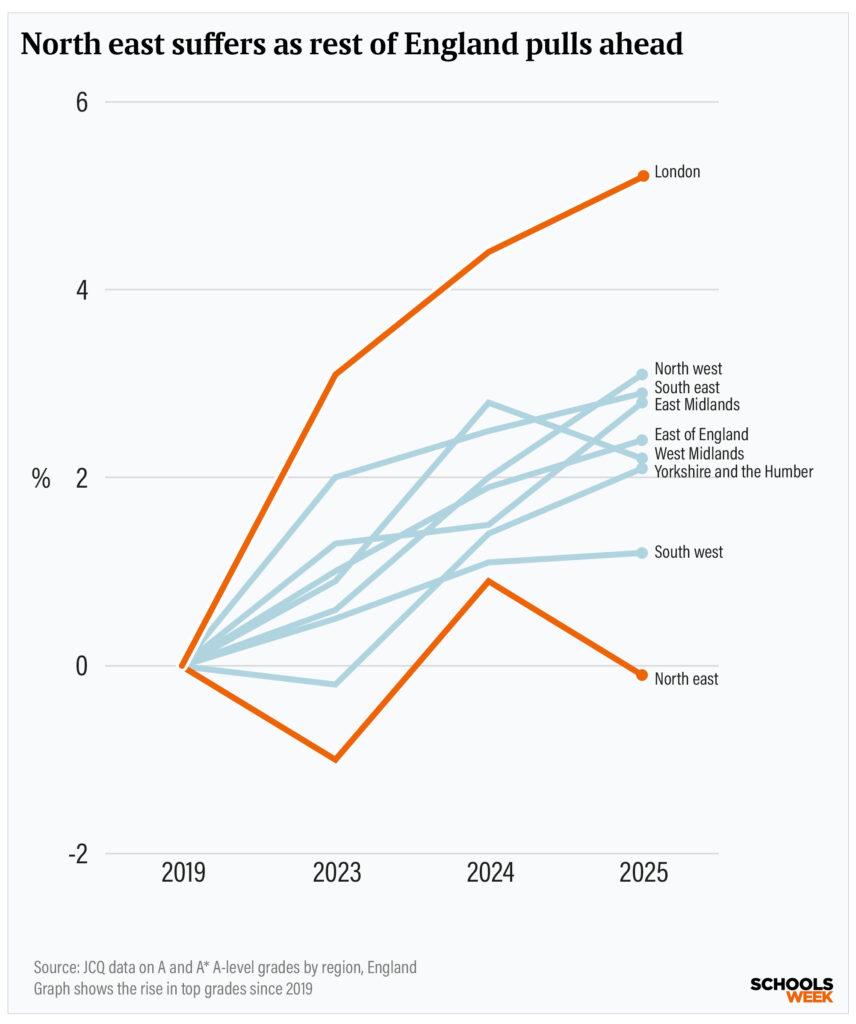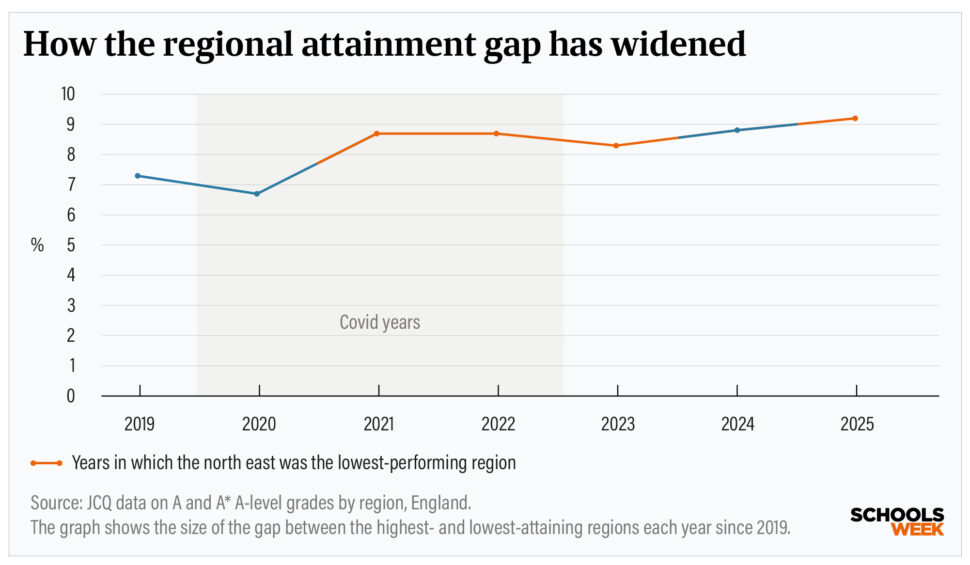“This is not about school quality…we cannot keep pretending the north east–London gap is about standards,” Chris Zarraga, the director of Schools North East, said
“It is about deep-rooted structural inequalities that no government has seriously addressed.”

Despite top grades rising slightly again across the country this year, the north east saw a four per cent drop in the proportion of As and A*s achieved by its youngsters.
It is now the only region in England where top grades are still below pre-Covid levels.
The proportion of A and A* grades by London students is now five percentage points higher than in 2019.
The widening regional attainment gap is now prompting warnings that opportunities for school leavers “depend on background rather than talent”.
Problem ‘not about standards’
“North East students have done brilliantly again this year, but the structural gap between our region and London has grown yet again,” Zarraga said.
“Without urgent, sustained action … the gap will keep widening, and it will not be because our students or teachers are any less capable.”
The proportion of A and above grades achieved by youngsters in London schools, the top-performing region, was 32.1 per cent this year.
This is compared to 22.9 per cent in the north east, which registered the smallest proportion of top grades – and fell below the 23 per cent achieved in pre-pandemic 2019.
The attainment gap between the north east and London is now 9.2 percentage points.
This is wider than the gap between the best- and lowest-attaining regions last year, which was 8.8 percentage points.
Meanwhile, every part of the country except the north east has recorded improvements in their top grades since 2019. Seven of the eight other regions are now achieving top grades that are at least 2 percentage points higher.

University gap widens too
However, the region ranks better than both the east and west Midlands when comparing the proportion of C grades and above. But again it is still the only region at this pass rate where scores are below pre-Covid.
The gap is widening elsewhere, too.
Just under 25 per cent of 18-year-olds from the north east secured a university place on results day, compared to 43.4 per cent of those from London.
According to the government, the gap is “now 18.5 percentage points, which is the highest on record”. In 2019, the figure stood at 11.9 percentage points.
Henri Murison, CEO of the Northern Powerhouse Partnership thinktank, said: “The pandemic has had long-lasting consequences and the grades our young people are using to apply for the most competitive university or apprenticeship places remain lower than those in regions such as London.”
Why is the A-level gap growing?
But what’s fuelling the growing attainment gap?
Ofqual chief regulator Sir Ian Bauckham told Schools Week there are likely a “range of factors playing into this phenomenon” of “significant differences between the top and the bottom end of the regions table”.
“The prior attainment of A-level students now is stronger than it was back then [in 2019],” he said. “It may be, though, that that pattern isn’t even across the country, and the A-level cohort in the north east is slightly different in shape.”
He also said a 60 per cent rise in students finishing T-levels this year has created “quite a lot of turbulence in the system” and it’s “possible” this could be “playing out slightly differently in one region, as opposed to other regions”.

But he was unable to provide conclusive answers.
Paul Whiteman, of NAHT, said the issue “needs closer investigation. This regional disparity has grown over the past decade, and the reasons need to be properly understood if they are to be tackled.”
He thinks factors could include the “impact of Covid and the cost-of-living crisis, to specific areas of poverty and varying investment into education, health, social care and other support services and infrastructure in the London and the south compared to the north”.
Absence, exclusions, SEND all higher in north east
The region certainly seems to be harder hit by issues that have worsened post-Covid.
Schools in the north east had the highest absence rate in England in the 2024-25 autumn term at 6.86 per cent, compared to 6.38 per cent nationally. Almost one in five pupils in the region are severely absent (missing at least ten per cent of classes) – again, the highest of any region.
London outperformed every part of the country in both metrics.
Latest government figures also show north east schools excluded pupils at a higher rate than anywhere else. In 2023-24, there were 18 suspensions for every 100 pupils in the north east, compared to six in London.

And the needs of pupils are also higher. Schools North East highlighted the region has nearly a third of pupils eligible for free school meals, compared to a quarter nationally. Meanwhile, it has the highest rate of pupils with SEND and the second-highest rate of pupils with education, health and care plans.
Pepe Di’Iasio, general secretary of the ASCL school leaders’ union, said the “socioeconomic factors represent a massive challenge, not only for the education sector but our society as a whole”.
“We have to stop merely talking about these issues and actually address them with investment in communities suffering from generational disadvantage. This cannot be solved by schools and colleges alone but must also involve action to boost the opportunities available for young people.”
Focus change on early years and post-16
Zarraga believes that without “urgent, sustained action” to tackle “structural inequalities” the gap between north east and London “will keep widening”.
Schools North East is calling on the government to “ensure long-term, fair funding that reflects regional needs and costs”, with a particular focus on “long-term deprivation”.
The group pointed to just 16 per cent of north east schools applying for condition improvement fund cash for building repairs were successful last year, compared to 35 per cent nationally.

It also said school readiness is “one of the most persistent barriers” to attainment, with gaps in language development, communication skills and social readiness “all evident at age four”.
And “limited access to high-quality early years provision, reduced numbers of health visitors, and the loss of Sure Start” has left “many children starting school already behind their peers”.
Schools North East also urged ministers to “deliver a post-16 system where all routes, academic and vocational, are high-quality, respected, and linked to real opportunities in the north east economy”.
James Toop, CEO of education charity Teach First, added many pupils, “especially from the poorest backgrounds”, will have received “results that don’t reflect their potential”.
“No results day should come with a postcode lottery,” he said. “We must get the very best teachers to where they’re needed most, and back schools working in the most disadvantaged communities with the resources and investment they deserve to ensure every child can reach their dreams.”
Government: ‘There’s entrenched divide’
Education secretary Bridget Phillipson and schools minister Catherine McKinnell both represent north east constituencies.
Phillipson said: “Every single young person collecting their results [yesterday] should have the opportunity to pursue their dreams…but too often, opportunities depend on background rather than talent.

“The entrenched divide in outcomes seen over the last few years and the lack of progress for children from white working-class backgrounds is particularly concerning.”
Ministers are due to publish the schools and post-16 skills white papers later this year.
They say the documents will outline “further reforms to build an education system where every child and young person can achieve and thrive, regardless of their background or circumstances”.
Phillipson added: “This government won’t stand by and accept the entrenched inequalities that continue to blight the life chances of too many young people, especially those from white working class backgrounds who have long been overlooked.
“Through our plan for change we are breaking the link between background and success, starting with reformed early years and revitalised family services, through to ambitious reforms to our school and post-16 system to make sure every young person, wherever they grow up, is truly ready for life and work.”











There is no measurement for aspiration – but that is what we need if we are to judge schools fairly. The most deprived communities tend to have the lowest aspirations and, hence, the worst results at school. The exception is in poor but migrant communities (London is the best example) which count as deprived (based on income) but have huge aspirations – that’s why they are migrants. ‘Getting the best teachers to the most deprived areas’ is a red herring and assumes that teachers in deprived schools are rubbish. Raising the aspirations of these communities is the key – but this requires enormous investment and time and no government has yet had the ambition to tackle this – nor has any government understood it.